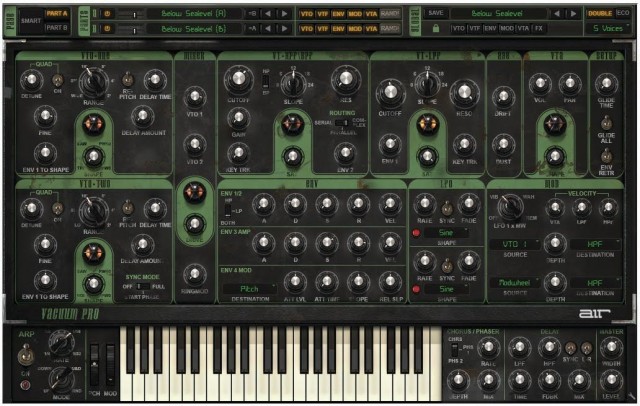At the 2013 NAMM Show, AIR Music Technology introduced Vacuum Pro Polyphonic Analog Tube Synthesizer.
Vacuum Pro is described as a ‘polyphonic analog tube synthesizer’. It descends from the original monophonic Vacuum, developed by AIR as part of the Pro Tools Creative Collection from Avid.
The new Vacuum Pro is polyphonic, offering up to 160 oscillators plus substantial improvements in both horsepower and features.
Vacuum Pro Polyphonic Analog Tube Synthesizer
The Vacuum part of the name Vacuum Pro relates to the six tube circuits that lend a particularly ‘analog’ flavor to each of the main synthesis modules—oscillators, filters, mixer, etc. Modulation effects, delay, and a classic arpeggiator add motion and depth to the sound.
Vacuum Pro sounds are created using one or two parts. When creating parts, the Smart Sound Randomizer allows new values to be created instantly for any or all selected modules. This makes it easy to keep an interesting oscillator sound, for example, while quickly trying out new filter settings. In addition, the Parts Lock feature allows the current settings of any modules (both parts) to be retained when changing sounds, providing a fast way to combine elements from different patches.
Vacuum Pro Polyphonic Analog Tube Synthesizer is for 32- or 64- bit Mac or Windows systems, AAX, VST, AU, and RTAS formats. Pricing is TBA.


Very interested in this!
AIR ?
They are famous for something else in the audio world
They make instruments for ProTools…
it’s digital. end of story. there’s no tubes. seems like a desperate marketing measure.
If you like this product then be sure to check out Softube’s offerings…classic vintage gear recreated as vsts for reasonable prices! I mean who wouldn’t want to pay 350 bucks for a 4 band EQ? It’s like wine, the more it costs, the better it sounds/tastes!
I agree. How can a software instrument be a tube instrument. They may as well say it is powered by a pterodactyl.
Who’s going to sell me the tube-based PC to run it on?
YEH POLY TOOBS!!!!!!
THATS MORE THAN ONE TOOB THATS MANY TOOBS
TOOBS ARE BETTER THAN NO TOOBS
I WANT THIS FOR MY IPAD
IT NEEDS TOOBS TO MAEK IT WARMER AND MORE THREE DEE.
YEH TOOBS
soft synths are the equivalent of wearing condoms, its just not the same as the real thing!
VA’s are the same as wearing condoms, not the same as analog. How do like that comparison, KingKorg?
Analog is overrated, it’s just a way to keep selling old technology to people…kind of like all the vinyl revivalists…just a way to keep people buying physical copies of music. I’m waiting for some hedge fund to buy a bunch of patents on CRT video screens and start a viral marketing campaign about how “CRT is is so much warmer than flat screen!” and everyone will be paying premium prices for some big bulbous CRT box so they can experience the “warmth” too!
that’s funny because some graphic artists do prefer CRT because of perceived differences in colour reproduction..
while some new technology might be better in 9/10 ways over the old tech, there will always be people who value that 1 feature that didn’t improve (or got worse) in the new version
The ability to lock the different sections is cool, that’s something I’d like to see appear in more softsynths
wonder if they’re going to release a cracked version of their own app.
You guys are balmy. This is a great idea. People holler for something “new” all the time and there’s clearly a lot of clamor for gritty or carefully distorted tones. This makes something old available in at least SOME form, which is far better than nada. The mono version had a great screaming, barely-controlled sort of voice. It’ll be fun to hear how people approach it as a poly. It’ll take a different touch to keep it from becoming muddy.
No, plug-ins aren’t “as good” as the warmed-up hardware in a couple of ways, but they’re better in others. How about some love for someone having a VST Synthex who would ever be able to touch one otherwise? Same here. Real tubes are like bucking broncos, but the sound is still great. I’ll take a digital approximation that gives me 4/5 of the core attributes, no problem!
Besides, that steampunk GUI is perfect for the job.
I would love to hear Eric Barbour’s opinion about this.
I think Eric would say “160 oscillators? That’s gonna take a LOT of tubes!”
me gusta!
bla bla bla other comments… I have the mono version and really rocks, compared with Sylenth or Massive (they claim to have the real analog circuits on yours VSTi) Vacuum really sound warm and fat and bright, it remember me the classic sound from Yazoo or the first album of Depeche Mode, classic analog basic sound from Pro One or Jupiter 4. Thank you.